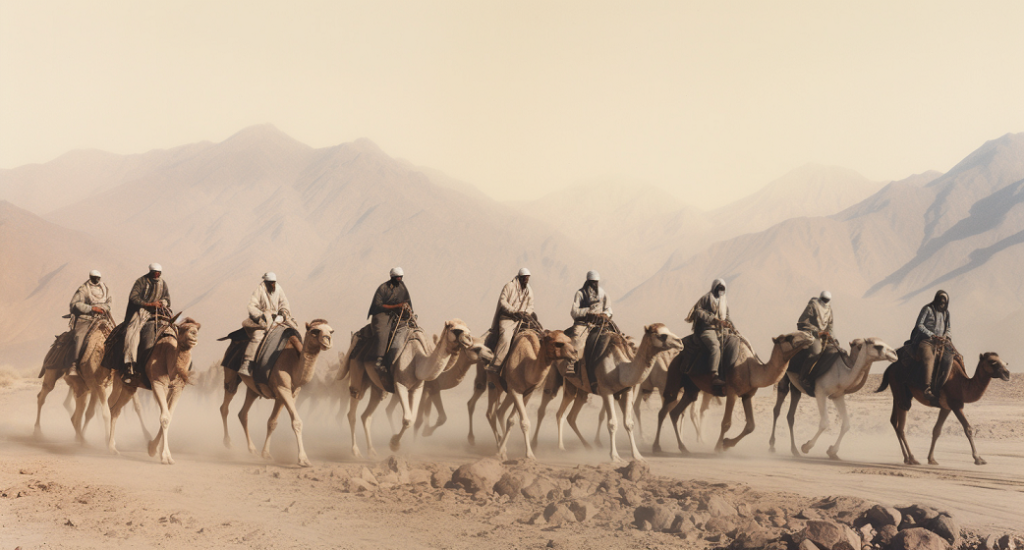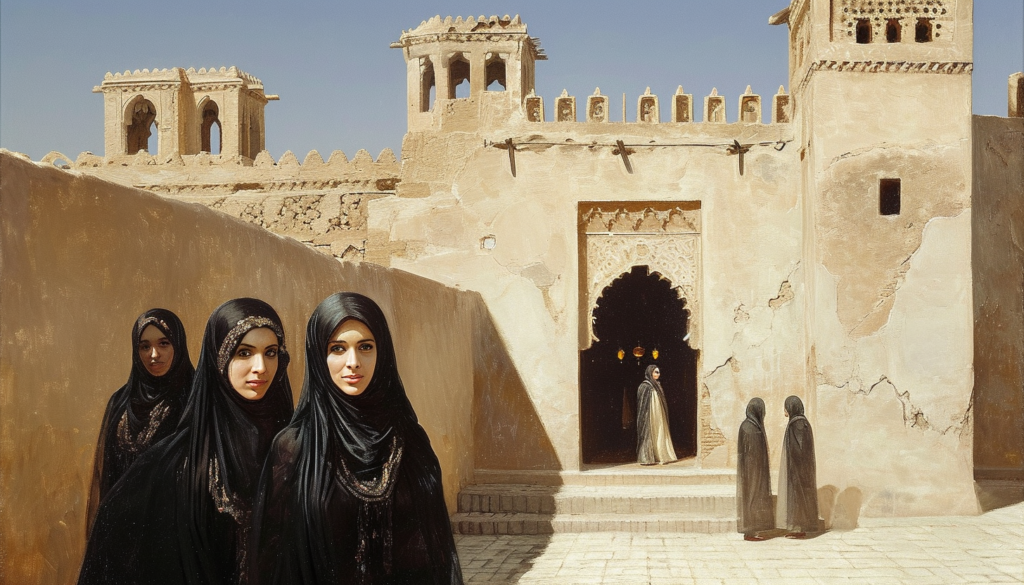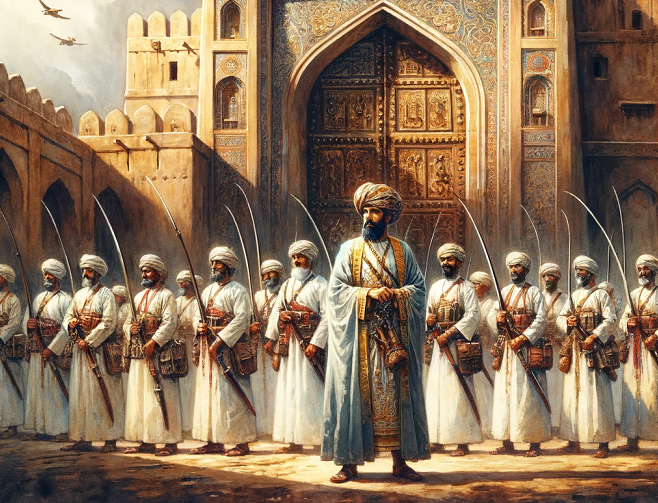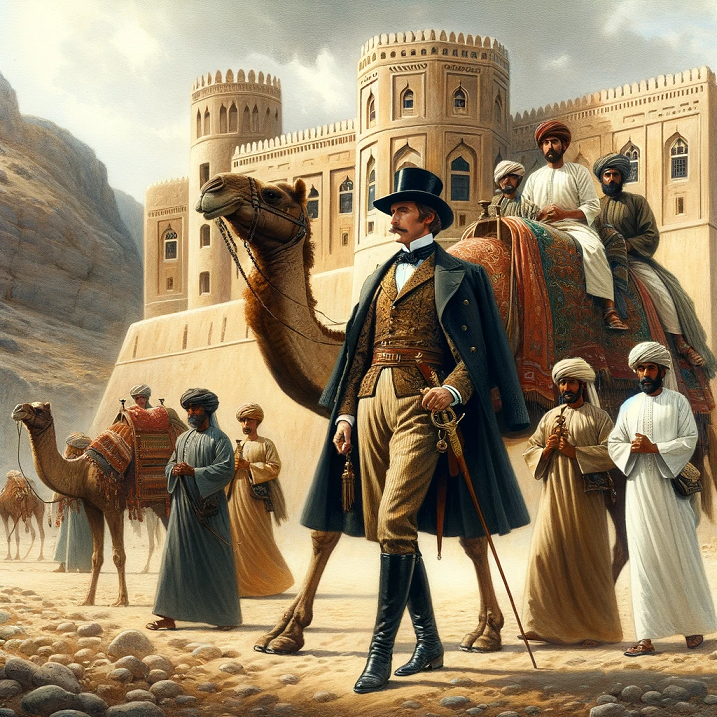In the early 19th century, James Wellsted, an explorer of notable repute, embarked on a journey across Oman, documenting his experiences in the seminal work “Travels in Arabia“. Wellsted makes meticulous observations during his travels about perilous roads infested with robbers, the lush landscapes surprising to the travellers, and the complex social and political dynamics of the regions visited, including Manah and Nizwa. Through Wellsted’s narrative, we explore the essence of Oman, uncovering the rich tapestry of its culture, the architectural marvels of its towns, and the vibrant life of its people, alongside interactions with tribes such as the Ghafari and the Y’harabi.
Departure from Samad Oman
Wellstead’s journey to Nizwa begins with an earnest departure from his host, the esteemed sheikh of Samad, a town located about 100km from his destination, marking the beginning of a significant passage fraught with danger. The necessity of a large escort, comprising about seventy men, underscores the perilous nature of their route, known for its susceptibility to bandit attacks on smaller groups even under the light of day.
the road between this place and Neswah is said to be infested with robbers, who plunder small parties in open day.
James Wellsted: Travels in Arabia
Their trajectory, taking them through a region peppered with numerous villages. A critical halt at a place Wellsted calls ‘Okahil’ for the purpose of refreshing their guard highlights the communal effort in ensuring safe passage. This brief interlude, marked by the assembly of eager volunteers, is telling of the inherent risks of their journey and the local populace’s readiness to safeguard against the dangers that beset their path.

We halted 45 minutes at Okahil, in order to obtain a fresh guard ; the men collected for this purpose were apparently volunteers, who seemed to enjoy the fun a good deal, although in some places they proceeded with their matches lighted, and under every preparation for an attack.
James Wellsted: Travels in Arabia
Bandit Raids in Oman
As Wellsted and his party ventured further into the Arabian expanse, their encounters with both the natural and human elements of the region offered a rich tapestry of experiences. The presence of robbers, originating from the Western Desert in formidable groups and mounted on swift camels, introduces a constant element of danger. These marauders, adept at swift raids and quicker retreats, often targeted the African slaves of town Arabs, integrating them into their ranks or forging matrimonial alliances, thus blending cultures in the harshness of desert life.
They often possess themselves of the African slaves belonging to the town Arabs, which they bring up in the same habits as themselves, and not unfrequently marry their daughters to them.
James Wellsted: Travels in Arabia
The narrative notes a peculiar recklessness amongst the locals regarding their own safety, with gun-shot and sword wounds being a common sight. Wellsted speculates, with a hint of irony, that such injuries were “not unfrequently occasioned by their own or their friends’ carelessness.” This observation reflects a society where the harshness of the environment breeds a certain nonchalance towards danger, further emphasised by the image of men clustering around suspicious areas with matches lit, presenting a paradoxical fear of external threats amidst their own hazardous practices.
Everybody on a journey carries a match lighted, and no more care is taken of their matchlock then, than when unloaded ; so that, when these men clustered round upon our approach to any suspicious spot, I always thought there was more reason to dread danger from my friends than foes.
James Wellsted: Travels in Arabia
Upon reaching Tulhat (Qal’at), the description of the town and its surroundings provides a stark contrast to the dangers of the journey. With its small forts perched atop hills and extensive date groves, Tulhat emerges as a bastion of civilisation in the midst of a challenging landscape. The strategic significance of these forts, alongside the abundance provided by the date groves and a noble stream of water, paints a picture of a community thriving against odds, embodying resilience and ingenuity.
Health Concerns
Within the narrative, an episode at Tulhat brings to light the health risks inherent to the journey. Wellsted’s decision to sleep in the groves, contrary to his usual caution, resulted in two of his servants being struck down by severe fever the following day. This incident underlines the harsh realities of travel in such environments, where even the most mundane decisions can have serious health implications.
Hitherto I have avoided sleeping in these groves, but here we were compelled to do so, and the consequence was what I anticipated, two of my servants being next day attacked with severe fever.
James Wellsted: Travels in Arabia
Arrival in Manah
The next leg of Wellsted’s journey brought him to Manah, a town distinct from others in its open-field cultivation, presenting an oasis of greenery amidst the arid expanse. This lush landscape, adorned with almond, citron, and orange trees, emitting a delicious fragrance, elicited exclamations of astonishment from Wellsted and his companions. Their marvel at finding such greenery in a land previously conceived as barren reflects a moment of revelation, challenging preconceived notions of Arabia as solely a desert wasteland.
Minna differs from the other towns in having its cultivation in the open fields. As we crossed these, with lofty almond, citron, and orange-trees, yielding a delicious fragrance on either hand, exclamations of astonishment and admiration burst from us.
James Wellsted: Travels in Arabia
Wellsted’s rhetorical question, “Is this Arabia,” encapsulates this shift in perception, highlighting the diversity of the Arabian landscape and its capacity to astonish even the most seasoned travellers.
the atmosphere was delightfully clear and pure ; and, as we trotted joyously along, giving or returning the salutation of peace or welcome, I could almost fancy we had at last reached that “Araby the blessed,” which I have been accustomed to regard as existing only in the fictions of our poets.
James Wellsted: Travels in Arabia

Tribal Feuds
Manah’s agricultural bounty is not its only noteworthy aspect. The town finds itself in a precarious political situation, caught in a feud with the neighbouring Ghafari tribe, which does not recognise the authority of the Imam. This conflict underscores the complex socio-political fabric of the region, where tribal affiliations and historical grievances dictate the dynamics of power and influence.
The Ghafari are among the noblest of the tribes of Oman, and, with the Y’harabi, have at different periods respectively furnished an Imam. Their power is now limited to the possession of a few castles, from which they occasionally sally and annoy the surrounding country.
James Wellsted: Travels in Arabia
Manah’s Characteristics
Upon delving deeper into the essence of Manah, Wellsted paints a vivid picture of a town that, despite its ancient roots purportedly dating back to the era of Nushirvan’s invasion, bears no overt signs of antiquity. Instead, Manah presents itself through the lofty stature of its buildings and the strategic placement of two square towers that dominate its skyline. These architectural marvels, constructed with rudimentary materials yet achieving remarkable heights, stand as a testament to the ingenuity and resilience of its inhabitants. The towers, with their slender bases and imposing height, serve as defensive structures.
The guards, who are constantly on the look-out, ascend by means of a rude ladder, formed by placing bars of wood in a diagonal direction in one of the side angles, within the interior of the building. The country in every direction around this town is flat and even; and the commanding view they obtain from their summit enables them to perceive from a long distance the approach of an enemy.
James Wellsted: Travels in Arabia
The social fabric of Manah, particularly the boldness and vivacity of its female population, adds another layer to Wellsted’s narrative. Contrary to the author’s initial apprehensions about theft, he finds the women to be paragons of honesty, a discovery that pleasantly surprises him. Their frolicsome nature and incessant laughter breathe life into the town, reflecting a community where joy and resilience coexist amidst the backdrop of ongoing tribal conflicts and the harshness of the surrounding landscape.
The females here are equally bold, and more numerous than those of Ibrah. Yet, notwithstanding my tent was constantly crowded with them, and a temptation to pilfer must have been presented in a hundred seducing and facile forms, I did not miss the most trifling article.
James Wellsted: Travels in Arabia

Journey Towards Nizwa
Progressing from Manah, Wellsted’s narrative transitions towards the journey to Nizwa, unfolding across a tapestry of cultivated grounds and the looming presence of the Jebel Akhdar range. This passage through diverse terrains—from lush agricultural fields to the arid base of low-lying hills—illustrates the geographical contrasts that define Oman’s landscape. The approach to Nizwa, marked by a change in scenery and the strategic significance of the small forts and villages like Rhodda and Furk, underscores the region’s blend of natural beauty and historical fortification against external threats.
Upon arrival in Nizwa, Wellsted is greeted by a scene that encapsulates the town’s standing in the local power dynamics. The Sheikh of Nizwa, flanked by an armed guard, symbolises the authority and respect commanded within the region. The initial reception, tense and formal, quickly transforms into one of hospitality and intrigue once the purpose of Wellsted’s visit is understood. This transition from suspicion to welcome reflects the complex interplay of trust and caution that characterises interactions in a region fraught with tribal rivalries and political unrest.
I proceeded at once to the residence of the Sheikh, who possesses great influence in these parts. We found him seated before the castle gate, with an armed guard of about fifty men, who were standing on either side. The whole town had followed us thus far; but directly Sayyid S’aids letter was produced, and it was discovered who we were,they immediately dispersed, and the Sheikh expressed his regret that I had not sent him an intimation of my intended visit, in order that he might have met me on the road with A proper escort.
James Wellsted: Travels in Arabia
The Sheikh’s later request for brandy, and the indulgence of his companions in this forbidden pleasure, reveals a facet of local customs and interactions with foreign influences that Wellsted navigates with a mix of surprise and diplomacy. This episode, along with the casual departure of a Moolah upon the scent of tobacco, paints a vivid picture of the cultural nuances and personal liberties that exist beneath the surface of formal social structures.
During the evening, the Sheikh, accompanied by a few of his friends, paid us a visit. To my surprise the latter applied to us for brandy, and drank as much as was given them without scruple; nor did the Sheikh express any disapprobation of such an indulgence. I found they had been in the habit of procuring spirits from Maskat, where, though they are contraband, a considerable quantity is smuggled on shore from the Indian ships.
James Wellsted: Travels in Arabia
Exploration of Nizwa
In Nizwa, Wellsted’s experiences reach a new depth as he explores the fort, deemed impregnable by the locals. This fortress, with its circular form and towering stature, stands as a monument to the town’s strategic importance and architectural prowess. The detailed description of the fort’s defensive features, including the multiple iron doors and the solid mass of earth and stones filling its interior, showcases the ingenuity of ancient construction techniques aimed at withstanding sieges. The presence of wells within the fort, ensuring a supply of water, alongside dry wells used for storing ammunition, reveals a meticulous planning for self-sufficiency in times of conflict.
In order to render appearances more imposing, a janitor behind each inquired the purport of our visit; and, being told we were servants of the Sooltan, he removed several locked bars and chains, and we then passed on.
James Wellsted: Travels in Arabia
The narrative then shifts to the broader social and economic landscape of Nizwa. The town, similar in size to Manah but distinguished by its more extensive groves and the cultivation of sugar-cane, represents another facet of Oman’s agricultural richness. The method of sugar production, akin to that in India, signifies the exchange of knowledge and trade practices between regions. This, along with the local crafts of copper pot making and the weaving of cloth and mats from rushes, paints a picture of a vibrant community where traditional crafts flourish alongside agricultural pursuits.
Neswah in extent resembles Minna, but the groves are more numerous. A great quantity of sugar-cane is grown, and its produce manufactured here by a process similar to that adopted in India, from whence they appear at a very late period to have borrowed it, as none was made at Maskat in 1760, when Niebuhr visited it.
James Wellsted: Travels in Arabia
Wellsted’s observations on the communal life in Nizwa, from the gathering of women spinning cotton beneath the groves to the men attending looms, illustrates the gendered division of labour and the communal aspect of craft and trade.
Preparing cotton in the yarn is the principal occupation of the females. In the cool season they may be perceived coming out from beneath the groves with their spindles after breakfast, to enjoy the warmth of the sun’s rays. The men alone attend the looms.
James Wellsted: Travels in Arabia

Through Wellsted’s detailed observations, this exploration of Nizwa provides an in-depth look into the town’s defenses, farming methods, and community interactions. It paints a picture of a community deeply entrenched in its traditions and environmental challenges, yet displaying incredible resilience and a profound cultural legacy. Nizwa is portrayed not merely as a place on the map but as a vibrant, active society enriched with unique traditions, facing its own set of challenges, and embracing distinct ways of living. This account adds a valuable perspective to Omani travel writing, bringing to life the essence and spirit of Nizwa as experienced by Wellsted.

